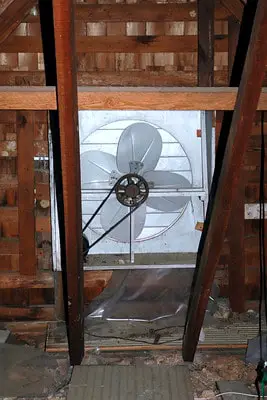
Manufactured homes often consist of cooling and heating systems for keeping acceptable interior temperatures. In most cases, these systems consume more power than any other appliance in the household thereby bloating the homeowner’s energy bills. That’s probably why you need to install an attic fan. The attic works by eliminating stale air from the home and it is located close to the top edge of the wall, or the “attic.”
Improper venting sometimes causes accumulation of the warm air in the interior which not only increases the interior temperature but also makes the air unbreathable. One of the best ways of eliminating this problem is having an effective attic fan in place. Although the attic fan does not ventilate the air as perfectly as a full A/C unit does, it is slow on your electricity.
But, can you even install an attic fan on a manufactured home? Yes, but it can depend on an array of factors. For instance, a significant number of manufactured homes come with 3/12 pitch roofs. Besides being almost not flat, these roofs come with vaulted roofs which makes the installation of attic fans near impractical. Vaulted ceilings normally don’t have a real space to support attic fans; some of these sorts of roofs come with flat ceilings and might support attic fans to some extent.
Venting the sidewalls of such a home would be useless as insulation and framing would prevent the air from circulating properly. In such cases, therefore, a simple exhaust fan positioned on the very top section of the exterior wall would improve the effectiveness of the attic fan.
Besides the pitch of the wall, other factors may kick in: are your walls shingled? Is the roof equipped the with a rubberized roof coating (Kool Seal® Tundra for example)?
However, if your home has ample power supply and the roof is in the correct conditions, you can install attic fans without worry.
4 Manufactured Home Attic Fan Shopping Factors
Here are other factors you must keep in mind when installing attic fans:
Factor #1: The size of your home
The Attic fan can produce disastrous results if you don’t consider the size of your home when choosing one. Before installing a fan for the whole living room, take the measurements of the living space and the space covered by the attic, often in cubic feet (ft3).
If, for example, your manufactured home has an overall floor space of 2,000 ft3 with 8-foot ceilings, the total volume would 16,000 ft3. If the ceiling were 10 feet, the total volume would be 20,000 ft3 (about 25 percent more).
The rule of thumb when deciding on volume is that the attic fan should move from 2 CFM to 3 CFM (cubic feet per minute) for every square foot of indoor space. This rule is based on the standard 8 feet ceiling. So, if your mobile home is, let’s say 2,000 sq. ft. Consider multiplying the area by 2 CFM to 3 CFM – that’s going to give you a range of between 4,000 and 6,000 CFM system.
Factor #2: Presence of fan vents and their size
Attic fans are sometimes accompanied by attic vents to produce the best of desired results. If you have these vents already in place, measure their size before you choose an attic fan.
To get a rough estimate of the size of these vents, you will need about 1 sq. ft. for every 750 CFM, meaning that, if you choose to go with a 4,000CFM system, you will divide the 4000 CFM with 750 CFM to get 5.3 sq. ft. of attic venting.
If you choose a 6,000 CFM system, the attic venting will be 8 sq. ft.
Manufacturers sometimes label attic fans with CFMs (the amount of air stream they can move) and their diameter. For example, you may find a 36” diameter fan with a CFM of 7,000. A fan with a diameter of 30” is capable of moving about 5,500 CFM while a 24” fan might move around 4,500 CFM. Feel free to ask the contractor for guidance.
Factor #3: The attic design approach of your manufactured homes
A huge number of manufactured homes are made with soffit vents and passive ridges according to the stipulations of the HUD-code. A significant number of these homes employ the attic’s mechanical ventilation. Insulation is added on the floor of the attic on top of the truss bottom chords and gypsum board.
In some regions, often Florida and other states in the Deep South, the ducts are sometimes placed under the insulation within the attic.
According to the HUD-code, all single section houses with metallic roofs and no underlayment or sheathing are constructed with no attic ventilation. This sort of homes, therefore, comes with a seal covering the air paths between the attic and the living area, although the overall performance of the seals is largely unknown.
Although most of the building codes we use today, including the HUD-code, recommend specific attic ventilation without considering the climate of the area, it is starting to be apparent that we need to start to consider the locality’s climate when deciding the attic ventilation requirements as evidenced by ASHRAE’s recommendation.
Factor #4: The climate of your area
Again, you need to consider the climate of your region. If you live in a cold region, for example, you will need to install an insulation or winter cover to compliment your whole-house fan. This insulation cover should seal tightly to provide maximum insulation.
5 Things to know before installing attic fans in your manufactured home
As enthusiastic as you might be feeling now, just be in the know that attic fans can bring undesirable effects if you go ahead to install them in your manufactured home. While they might cut your energy consumption by around 30 percent and keep you cool all the time, they suck at it sometimes. Here is what you need to know before installing one:
1) Attic fans can be considerably noisy compared to any air conditioning or cooling equipment you know. So, you might need to put up with prolonged wheezing the whole time they’ll be at work.
2) Attic fans may pull radon gas from crawl spaces and machines into the living area’s conditioned space.
3) Attic fans can easily depressurize the gas/combustion appliances of your home and cause a backdraft. If a backdraft occurs, it can expose your home to carbon monoxide which is invisible and deadly.
4) Attic fans are very much capable of pulling conditioned air from all other occupied areas of your mobile home – this can only cause the air conditioner to run longer. If this occurs, it would mean more energy consumption and bloated energy bills. It doesn’t end there, the conditioned air may be replaced by the moist air from the outside which may end up making the room humid and uncomfortable.
5) Attic fans can cause your roof to leak just like any other device that requires an alteration on the roof’s structure.
Are Attic Fans Worth It?
Is it even worth it to install attic fans on your manufactured home? Absolutely yes, here is why you should have them installed as soon as possible:
A cooler home
There is always a need to lower the temperature of the home during hot conditions and the attic fan is one of the appliances that will do it for you. A hot attic creates a temperature difference in your home, with upstairs being warmer than downstairs.
During hot seasons, the sun heats the roof of your home and lets a significant amount of heat into the attic – basically, the attic serves as a “heat trap” the same way closed windows cause rooms to heat up.
The heat trapped by the attic can be enormous sometimes – can be as high as 150 degrees – and the attic fan is the best appliance to bring down the temperatures.
Keeping the mold at bay
You can’t realize how easily the mold can invade your home if your home is vented properly.
But, if you go for just 4 cold months without ventilating your home, you will have very moldy walls and roofs to clean. Also, during the hot weather, the A/C will crank plenty of cold air in the interior of the home.
When this hot air in the antics meets the cold air meets the warm air in the attics, a good environment for mold growth is created.
An attic fan is a perfect solution to prevent the growth of mold on attics as it removes all the moist and stale air from the home.
Conclusion
Attic fans are important in removing stale air from the interior of the home. Whether you can install attic fans on your manufactured home depends on an array of factors including the condition of the roof. It is important to understand what the HUD-code says about the installation of attic fans before installing one.
Also, consider calculating the capacity of the size and capacity of the room. The climate of your region can have an influence on the kind of attic fan perfect for the job and whether you should install it or not.
Attic fans aren’t entirely good for your manufactured home; they can bloat the energy bills and even cause carbon monoxide to build up in your home. But they are worth it.

